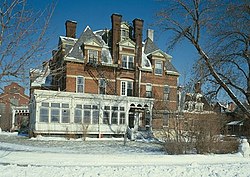
George Mortimer Pullman was an American engineer and industrialist. He designed and manufactured the Pullman sleeping car and founded a company town in Chicago for the workers who manufactured it. This ultimately led to the Pullman Strike due to the high rent prices charged for company housing and low wages paid by the Pullman Company. His Pullman Company also hired black men to staff the Pullman cars, known as Pullman porters, who provided elite service and were compensated only in tips.
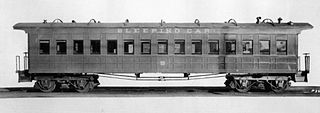
The sleeping car or sleeper is a railway passenger car that can accommodate all passengers in beds of one kind or another, for the purpose of sleeping. George Pullman was the American innovator of the sleeper car.

The Pullman Strike was two interrelated strikes in 1894 that shaped national labor policy in the United States during a period of deep economic depression. First came a strike by the American Railway Union (ARU) against the Pullman factory in Chicago in spring 1894. When it failed, the ARU launched a national boycott against all trains that carried Pullman passenger cars. The nationwide railroad boycott that lasted from May 11 to July 20, 1894 was a turning point for US labor law. It pitted the American Railway Union (ARU) against the Pullman Company, the main railroads, the main labor unions, and the federal government of the United States under President Grover Cleveland. The strike and boycott shut down much of the nation's freight and passenger traffic west of Detroit, Michigan. The conflict began in Chicago, on May 11 when nearly 4,000 factory employees of the Pullman Company began a wildcat strike in response to recent reductions in wages. Most of the factory workers who built Pullman cars lived in the "company town" of Pullman just outside of Chicago. Pullman was designed as a model community by its namesake founder and owner George Pullman. Jennie Curtis who lived in Pullman was president of seamstress union ARU LOCAL 269 gave a speech at the ARU convention urging people to strike.

Pullman, one of Chicago's 77 defined community areas, is a neighborhood located on the city's South Side. Twelve miles from the Chicago Loop, Pullman is situated adjacent to Lake Calumet.

The Pullman Company, founded by George Pullman, was a manufacturer of railroad cars in the mid-to-late 19th century through the first half of the 20th century, during the boom of railroads in the United States. Through rapid late-19th century development of mass production and takeover of rivals, the company developed a virtual monopoly on production and ownership of sleeping cars.

Founded in 1925, the Brotherhood of Sleeping Car Porters and Maids was the first labor organization led by African Americans to receive a charter in the American Federation of Labor (AFL). The BSCP gathered a membership of 18,000 passenger railway workers across Canada, Mexico, and the United States.
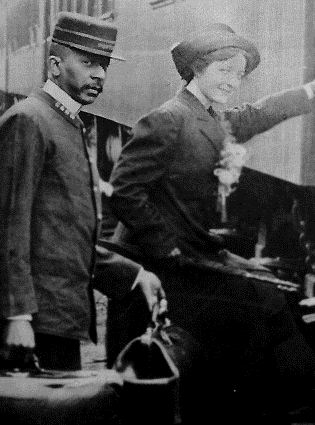
Pullman porters were men hired to work for the railroads as porters on sleeping cars. Starting shortly after the American Civil War, George Pullman sought out former slaves to work on his sleeper cars. Their job was to carry passengers’ baggage, shine shoes, set up and maintain the sleeping berths, and serve passengers. Pullman porters served American railroads from the late 1860s until the Pullman Company ceased its United States operations on December 31, 1968, though some sleeping-car porters continued working on cars operated by the railroads themselves and, beginning in 1971, Amtrak. The Pullman Company also operated sleeping cars in Mexico from the 1880s until November 13, 1970. The term "porter" has been superseded in modern American usage by "sleeping car attendant", with the former term being considered "somewhat derogatory".

The Super Chief was one of the named passenger trains and the flagship of the Atchison, Topeka and Santa Fe Railway. The then-modern streamliner was touted in its heyday as "The Train of the Stars" because it often carried celebrities between Chicago, Illinois, and Los Angeles, California.
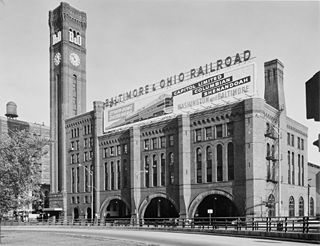
Grand Central Station was a passenger railroad terminal in downtown Chicago, Illinois, from 1890 to 1969. It was located at 201 West Harrison Street on a block bounded by Harrison, Wells and Polk Streets and the Chicago River in the southwestern portion of the Chicago Loop. Grand Central Station was designed by architect Solon Spencer Beman for the Wisconsin Central Railroad (WC), and was completed by the Chicago and Northern Pacific Railroad.

The Capitol Limited was an American passenger train run by the Baltimore and Ohio Railroad, originally between New York City and Grand Central Station in Chicago, via Washington Union Station in Washington, D.C., Camden Station in Baltimore, and Pittsburgh. For almost 48 years, it was the B&O's flagship passenger train, noted for personalized service and innovation. At the time of its discontinuation on May 1, 1971, when Amtrak took over most rail passenger service in the U.S., the Capitol Limited operated between Washington and Chicago.

Solon Spencer Beman was an American architect based in Chicago, Illinois and best known as the architect of the planned Pullman community and adjacent Pullman Company factory complex, as well as Chicago's renowned Fine Arts Building. Several of his other largest commissions, including the Pullman Office Building, Pabst Building, and Grand Central Station in Chicago, have since been demolished. Beman designed numerous Christian Science churches and influenced the design of countless more.

Pullman National Historical Park is a historic district located in Chicago, Illinois, United States, which in the 19th century was the first model, planned industrial community in the United States. The district had its origins in the manufacturing plans and organization of the Pullman Company and became one of the most well-known company towns in the United States, as well as the scene of the violent 1894 Pullman strike. It was built for George Pullman as a place to produce the Pullman railroad-sleeping cars.

A vestibuled train is a passenger train whose cars have enclosed vestibules at their ends, in contrast to the open platforms on early cars. Typically, a vestibule has doorways on either side to allow passenger entry and exit at stations, a door into the body of the car, and, at the car end, a doorway to allow access to the next car through a flexible gangway connection.

Prairie Avenue is a north–south street on the South Side of Chicago, which historically extended from 16th Street in the Near South Side to the city's southern limits and beyond. The street has a rich history from its origins as a major trail for horseback riders and carriages. During the last three decades of the 19th century, a six-block section of the street served as the residence of many of Chicago's elite families and an additional four-block section was also known for grand homes. The upper six-block section includes part of the historic Prairie Avenue District, which was declared a Chicago Landmark and added to the National Register of Historic Places.

The Robbins Park Historic District is a set of three hundred and sixty-eight buildings in Hinsdale, Illinois. Two hundred and thirty-two of these builds contribute to its historical value. The district was platted by William Robbins in the 1860s and 1870s following the completion of the Chicago, Burlington and Quincy Railroad. Wealthy entrepreneurs moved to the district beginning in the 1890s due to its natural beauty and proximity to major golf resorts. The district was added to the National Register of Historic Places in 2008 and features two houses previously honored by the register.

The Pullman Memorial Universalist Church of Albion, New York was constructed in 1894 as a memorial to the parents of inventor and industrialist George Mortimer Pullman. The structure, built of pink Medina sandstone and featuring fifty-six Tiffany stained glass windows and a Johnson pipe organ, is in the Orleans County Courthouse National Historic District. The building has been in constant use since its opening; the congregation affiliating with the Unitarian Universalist Association in 1961 but keeping its historic name.
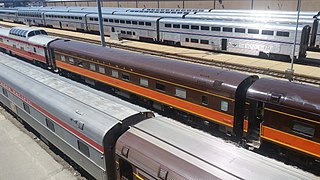
The Pine series was a fleet of sleeping cars built by Pullman-Standard in 1953. The cars were built according to Pullman plan 4183; each contained six sections, six roomettes and four double bedrooms. The cars were originally owned by the Louisville and Nashville Railroad (L&N), the Chicago and Eastern Illinois Railroad (C&EI), and the Nashville, Chattanooga and St. Louis Railway (NC&StL).

The Sun Lounges were a fleet of three streamlined sleeper-lounge cars built by Pullman-Standard for the Seaboard Air Line Railroad (SAL) in 1956. The cars featured a distinctive glazed roof area meant to capture the ambience of a dome car in a lower profile, as tunnels on the East Coast of the United States prevented the use of dome cars there. The Seaboard employed all three Sun Lounges on its flagship Silver Meteor between New York City and Miami, Florida. The cars later saw service with the Seaboard Coast Line Railroad (SCL) and Amtrak. Two of the three survive in private ownership.

The Seminole, also known as the Seminole Limited, was a passenger train operated by the Illinois Central Railroad, Central of Georgia Railway, and Atlantic Coast Line Railroad between Chicago, Illinois and Jacksonville, Florida. It operated from 1909 to 1969 and was the first year-round service between the two cities.
Pullman Hotels and Resorts is a French multinational upscale hotel brand owned by Accor. Pullman has 145 hotels and resorts in 42 countries spread across Africa, the Americas, Asia, Europe, the Middle-East and Oceania.
